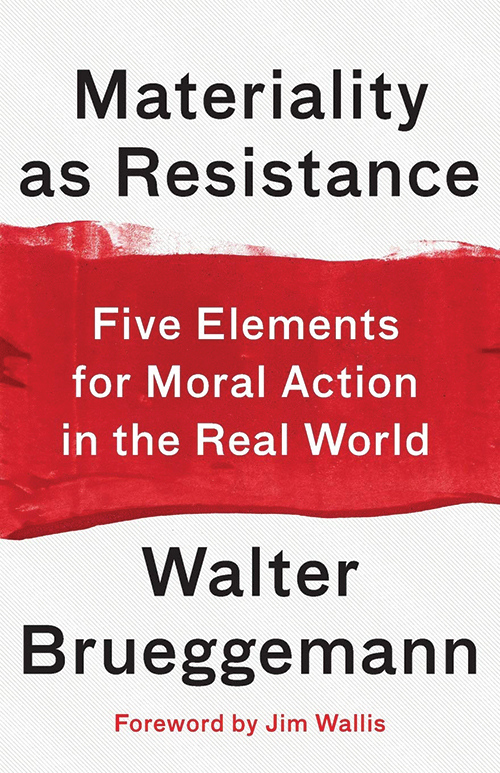
Materiality as Resistance: Five Elements for Moral Action in the Real World
Reviewed by Tom Paxson
January 3, 2021
By Walter Brueggemann. Westminster John Knox Press, 2020. 128 pages. $15/paperback; $12/eBook.
The title Materiality as Resistance points toward the bold use of a holistic perspective that transcends deeply ingrained conceptual dichotomies such as immaterial soul/material body, scarcity/abundance, human/non-human, animate/inanimate, natural/artificial, and hierarchy/web. Familiar themes of the inequity of social and economic structures, homelessness, consumerism, and hoarding are explored more deeply and extrapolated more broadly than you likely have encountered before, and in interesting and helpful ways. Brueggemann’s book is not didactic but invites us to come to a more holistic understanding of five key dimensions of our practical lives: money, food, the body, time, and place. The invitation is not to substitute one polar perspective for another but to transcend dichotomies in favor of a more balanced understanding.
I use the word “holistic” in a particular sense. Consider the question of whether the whole of “what is” is one reality comprising ever-changing multitudinous features, or whether “what is” consists of countless individual entities (“atoms” in the classic sense of indivisibles) that yield the whole.
In the West, the latter has dominated popular understanding for quite a while now, though it was a matter of contention in ancient times. The various lenses Brueggemann offers us are more reflective of the earlier perspective. Brueggemann is calling us to recognize the whole, which comprises the world and those that dwell therein, calling us to full, rich, satisfying lives within a living community, a living environment, a living earth, and a living spiritual reality—all one. Newly apprehending ourselves from this perspective, we are prompted to radically reimagine money, food, the body, time, and place, and with new eyes and new ears to see and to hear how we might be led to live.
Two examples from the chapter on food illustrate Brueggemann’s general approach. The first example is the shift from an orientation of scarcity to one of abundance. How is it that those of us with more than sufficient means treat food as a scarce resource, and those who live with very limited means treat food as though it is abundant? Social scientists have long noted that the special virtue of the poor is generosity. There is a willingness to share, a sense of interdependence.
An uncomfortable occasion in my life occurred around this issue during the 1998 Assembly of the World Council of Churches held in Harare, Zimbabwe. Participants were fed each day with lavish buffets for breakfast, lunch, and dinner. We were invited to serve ourselves from great tables laden with delicious food of many kinds, but instructed that on no occasion could we take any food from the dining area. We were particularly forbidden to give food to any of the many Zimbabweans who provided countless services for us—people who were hungry and whose families were hungry; people who, as the Assembly wore on, became increasingly angry regarding the great disparity they suffered. It was apparent that these Zimbabweans were being denied even the considerable leftovers from these meals. We were forced to recognize how we customarily treat food as a scarce commodity not shared.
The second example from the chapter on food shifts from a perspective of “efficiency” to one in which there are no “externalities”: the health of the whole network of resources is involved. Brueggemann compares the “efficiency” of large-scale industrial farming (with its heavy use of herbicides, pesticides, and other chemicals to support soil-depleting monoculture and of “factory” chicken, turkey, and hog production with their toxic waste generation) to the growing practice of local small-scale regenerative farming: raising a number of crops on the same land along with livestock (often chickens, ducks, goats, or sheep). This type of farming benefits soil, pollinators, water conservation, and local ecology.
If, as Howard Brinton argued in 1928, Friends’ starting point is living now in God’s realm and witnessing to God’s will, then this little book will help open our eyes and ears to how narrowly we Friends have, on the whole, understood these issues and how profound the implications might be of living more fully in the Spirit. The suggestion that we examine our lives through a lens of abundance rather than through that of scarcity with respect to food, resources, time, and place can help one reimagine what is possible and hence heed new leadings.
Materiality as Resistance is intended for adult religious study groups interested in recognizing and addressing the materiality of faithful living rather than having a program replete with answers. The open-ended questions at the end of each chapter are carefully designed to promote small group exploration of each aspect. The book should work splendidly for this purpose.
Tom Paxson is a member of Kendal Meeting in Kennett Square, Pa.


